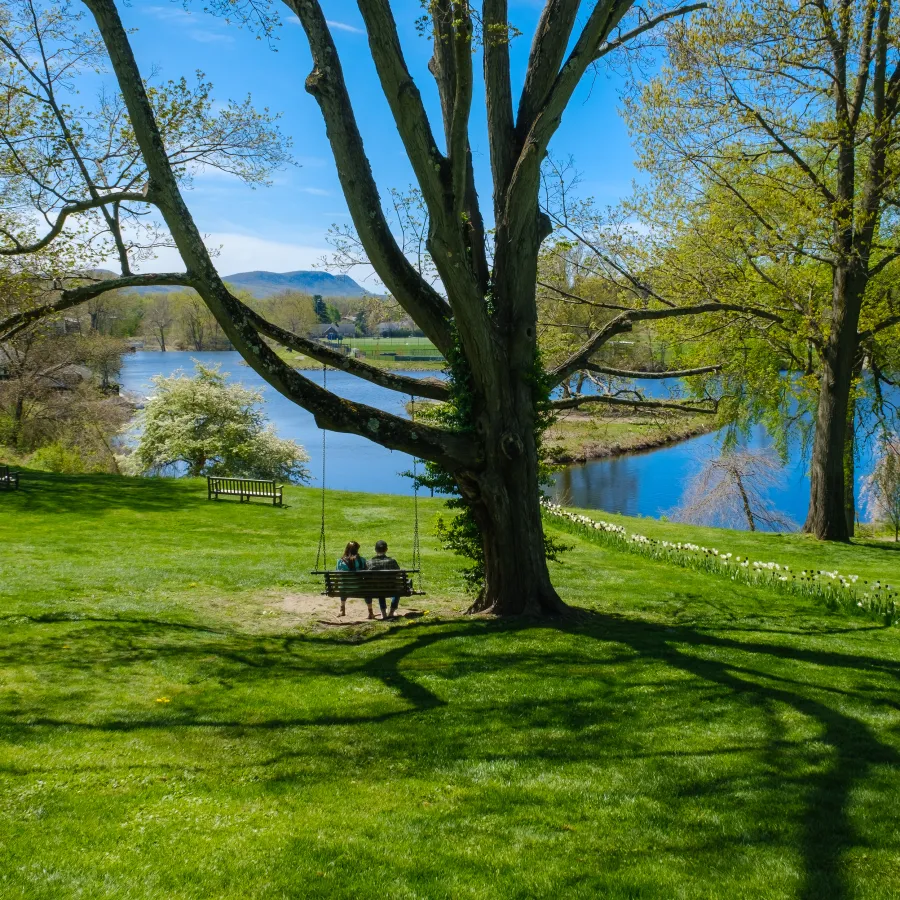2024 Annual Tree Removals Includes Sugar Maple Swing Tree
News

Published January 16, 2024
Every fall the Botanic Garden of Smith College staff assess both the physical condition and the content of the arboretum collections. For this assessment, staff curators and arborists determine if any arboretum trees are at the end of their healthy life, or if species pose an ecological threat to native habitats. As part of this routine collection care, the botanic garden, in conjunction with the Smith College Grounds Department, will begin the annual task of removing select trees from the arboretum and replacing them with trees that reflect Smith’s goals for the future of the campus landscape.
In total, five trees will be removed this year. Most of the tree removals planned for this year are linked to decay that is not uncommon for their age, and one is due to death from insect damage. Of particular note this year is a nearly century old sugar maple above Paradise Pond, that has been affectionately known as “the swing tree.” For generations of Smithies, the bench that hangs from its lowest branch has been a special place. The botanic garden is developing both short and long term plans to hold this cherished piece of Smith’s past and present. This spring, the swing will be moved to a new tree on campus and in the place of the old sugar maple, two new trees will be planted in hopes of some day bringing the swing back home.
“The arboriculture team at the college has carefully assessed the declining health of this beloved tree for many years now. It is a sad moment for all of us to see this tree go and important to us at the botanic garden that we ensure future Smithies have access to the simple joys that this tree and swing have given us. It makes us happy to know that there will be a swing tree on this beautiful vista again,” shared botanic garden Interim Director John Berryhill.
In 2023, more than 20 trees were planted on the Smith College campus. As new trees are planted in the spring, the botanic garden will develop the collection further, expanding its diversity and importance. Additional information about the tree collection at Smith's botanic garden is available on the botanic garden campus arboretum webpage.
FAQ:
Why is there an annual tree removal each year?
Each fall, the arborist team at the Botanic Garden of Smith College assesses the outdoor tree collections with both risk and collections value in mind. Typically the reason a tree is removed is because it is determined to present an unacceptable risk due to a combination of decay, poor branch structure and other factors. Occasionally trees are removed because they are determined to pose an ecological threat to native biodiversity.
How many trees get taken down each year on average?
Typically we have to remove five to ten trees. This number can be higher in years with destructive weather events.
Why does this iconic tree have to be taken down? What has been done to prevent the loss?
As with many old trees, this tree contained extensive decay on major limbs. The risk associated with that decay has been closely monitored and discussed by the arboriculture team for the past five years, and steps such as limb reduction and removal of deadwood have been taken to ensure that the tree did not pose an unacceptable risk to our community. The methodology used for this assessment was developed at the Botanic Garden of Smith College and published as the Botanic Garden of Smith College Tree Risk Management Plan. It is now being adopted by prominent botanic gardens, parks, municipalities and cultural institutions around North America.
What kind of trees are we going to replace this one with?
The botanic garden will select two native canopy trees, such as oak or tupelo trees, that have the potential to serve as a future home for a swing seat. They will be pruned to ensure strong branch structure and a suitable anchoring point. Having more than one will give us good odds that at least one will reach the necessary size to hold a swing for future Smithies.